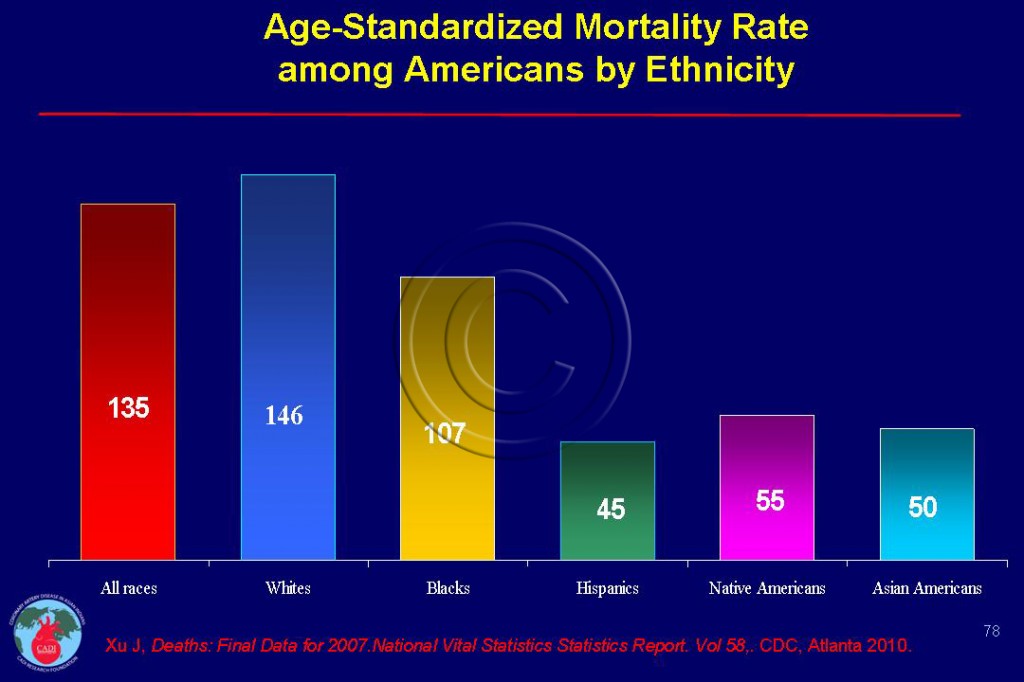Hispanic Heart Disease
- Despite high prevalence of risk factors, Hispanics have lowest rates of CAD mortality in vital statistics studies ─only one-third that of whites and blacks as shown in Figure 078.1
- The prevalence of obesity among Hispanics is high (29%) which is intermediate between blacks (36%) and whites (24%).2
- Hispanics have high prevalence and poor control of diabetes leading to greater complications.
- Hispanics also have lesser degrees of silent heart disease as measured by coronary artery calcium score (one-third of whites).3 Besides, the prevalence of high calcium scores (>400) that are generally equated with extensive atherosclerotic burden is particularly low compared with age-matched whites, despite evidence for a worse cardiovascular risk profile.4 Among the Hispanics, Mexican American have the highest prevalence of silent heart disease.5
- Despite the presence of diabetes in almost 50% and longer lesions than in whites, Hispanic patients were less likely to undergo coronary artery bypass graft surgery, especially repeat revascularization.6 This together with the low rates of high calcium score suggest less severe heart disease in this population.
- The observation that Hispanics have lower all-cause and cardiovascular mortality despite increased prevalence of diabetes and obesity, lower socioeconomic status and barriers to health care, has been termed the “Hispanic Paradox”. However, controversy and diverse confounding factors surround the Hispanic paradox.7, 8
- The Framingham Scores overestimated the risk for CAD in Hispanics as is true in Native American and Japanese populations.9
- Mexican Americans have a lower prevalence of high Lp(a) (8% than whites 19%). Decreased Lp(a) concentrations may account in part for Mexican Americans’ relative protection from CAD mortality.10
Sources
1. Xu J, Kochanek K D, Murphy S L. Deaths: Final Data for 2007.National Vital Statistics Statistics Report. Vol 58,. CDC, Atlanta 2010.
2. Differences in prevalence of obesity among black, white, and Hispanic adults – United States, 2006-2008. MMWR Morb Mortal Wkly Rep. Jul 17 2009;58(27):740-744.
3. Gardin JM, Allebban Z, Wong ND, et al. Do differences in subclinical cardiovascular disease in mexican americans versus European americans help explain the Hispanic paradox? Am J Cardiol. Jan 15 2010;105(2):205-209.
4. Reaven PD, Thurmond D, Domb A, Gerkin R, Budoff MJ, Goldman S. Comparison of frequency of coronary artery calcium in healthy Hispanic versus non-Hispanic white men by electron beam computed tomography. Am J Cardiol. Nov 15 2003;92(10):1198-1200.
5.Urizar GG, Jr., Sears SF, Jr. Psychosocial and cultural influences on cardiovascular health and quality of life among Hispanic cardiac patients in South Florida. J Behav Med. Jun 2006;29(3):255-268.
6.Parikh SV, Enriquez JR, Selzer F, et al. Association of a unique cardiovascular risk profile with outcomes in Hispanic patients referred for percutaneous coronary intervention (from the National Heart, Lung, and Blood Institute Dynamic Registry). Am J Cardiol. Sep 15 2009;104(6):775-779.
7. Lerman-Garber I, Villa AR, Caballero E. Diabetes and cardiovascular disease. Is there a true Hispanic paradox? Rev Invest Clin. May-Jun 2004;56(3):282-296.
8. Hunt KJ, Resendez RG, Williams K, Haffner SM, Stern MP, Hazuda HP. All-cause and cardiovascular mortality among Mexican-American and non-Hispanic White older participants in the San Antonio Heart Study- evidence against the “Hispanic paradox”. Am J Epidemiol. Dec 1 2003;158(11):1048-1057.
9. Kent DM, Griffith J. The Framingham scores overestimated the risk for coronary heart disease in Japanese, Hispanic, and Native American cohorts. ACP J Club. Jan-Feb 2002;136(1):36.
10.Haffner SM, Gruber KK, Morales PA, et al. Lipoprotein(a) concentrations in Mexican Americans and non-Hispanic whites: the San Antonio Heart Study. Am J Epidemiol. Nov 1 1992;136(9):1060-1068.


